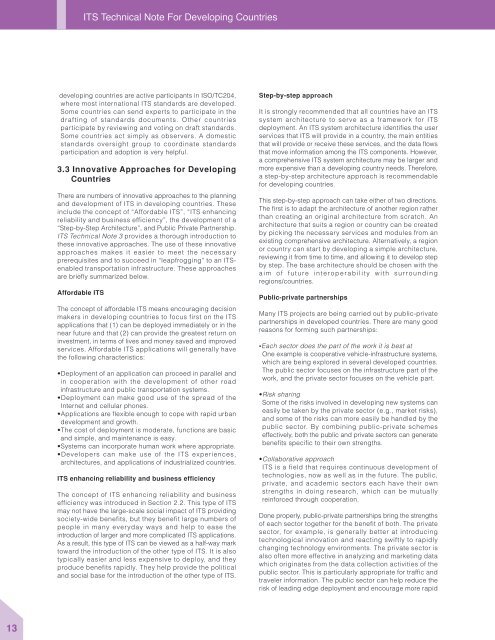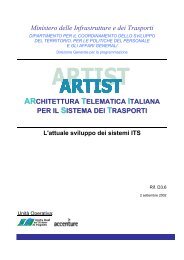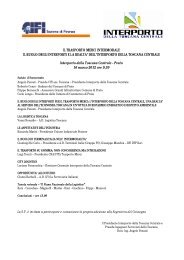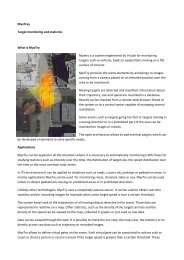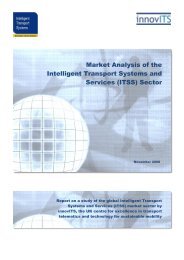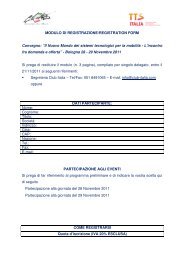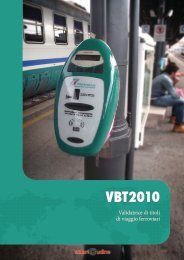ITS for Developing Countries ITS for Developing Countries - TTS Italia
ITS for Developing Countries ITS for Developing Countries - TTS Italia
ITS for Developing Countries ITS for Developing Countries - TTS Italia
Create successful ePaper yourself
Turn your PDF publications into a flip-book with our unique Google optimized e-Paper software.
<strong>ITS</strong> Technical Note For <strong>Developing</strong> <strong>Countries</strong><br />
developing countries are active participants in ISO/TC204,<br />
where most international <strong>ITS</strong> standards are developed.<br />
Some countries can send experts to participate in the<br />
drafting of standards documents. Other countries<br />
participate by reviewing and voting on draft standards.<br />
Some countries act simply as observers. A domestic<br />
standards oversight group to coordinate standards<br />
participation and adoption is very helpful.<br />
3.3 Innovative Approaches <strong>for</strong> <strong>Developing</strong><br />
<strong>Countries</strong><br />
There are numbers of innovative approaches to the planning<br />
and development of <strong>ITS</strong> in developing countries. These<br />
include the concept of “Af<strong>for</strong>dable <strong>ITS</strong>”, “<strong>ITS</strong> enhancing<br />
reliability and business efficiency”, the development of a<br />
“Step-by-Step Architecture”, and Public Private Partnership.<br />
<strong>ITS</strong> Technical Note 3 provides a thorough introduction to<br />
these innovative approaches. The use of these innovative<br />
approaches makes it easier to meet the necessary<br />
prerequisites and to succeed in “leapfrogging” to an <strong>ITS</strong>enabled<br />
transportation infrastructure. These approaches<br />
are briefly summarized below.<br />
Af<strong>for</strong>dable <strong>ITS</strong><br />
The concept of af<strong>for</strong>dable <strong>ITS</strong> means encouraging decision<br />
makers in developing countries to focus first on the <strong>ITS</strong><br />
applications that (1) can be deployed immediately or in the<br />
near future and that (2) can provide the greatest return on<br />
investment, in terms of lives and money saved and improved<br />
services. Af<strong>for</strong>dable <strong>ITS</strong> applications will generally have<br />
the following characteristics:<br />
•Deployment of an application can proceed in parallel and<br />
in cooperation with the development of other road<br />
infrastructure and public transportation systems.<br />
•Deployment can make good use of the spread of the<br />
Internet and cellular phones.<br />
•Applications are flexible enough to cope with rapid urban<br />
development and growth.<br />
•The cost of deployment is moderate, functions are basic<br />
and simple, and maintenance is easy.<br />
•Systems can incorporate human work where appropriate.<br />
•Developers can make use of the <strong>ITS</strong> experiences,<br />
architectures, and applications of industrialized countries.<br />
<strong>ITS</strong> enhancing reliability and business efficiency<br />
The concept of <strong>ITS</strong> enhancing reliability and business<br />
efficiency was introduced in Section 2.2. This type of <strong>ITS</strong><br />
may not have the large-scale social impact of <strong>ITS</strong> providing<br />
society-wide benefits, but they benefit large numbers of<br />
people in many everyday ways and help to ease the<br />
introduction of larger and more complicated <strong>ITS</strong> applications.<br />
As a result, this type of <strong>ITS</strong> can be viewed as a half-way mark<br />
toward the introduction of the other type of <strong>ITS</strong>. It is also<br />
typically easier and less expensive to deploy, and they<br />
produce benefits rapidly. They help provide the political<br />
and social base <strong>for</strong> the introduction of the other type of <strong>ITS</strong>.<br />
Step-by-step approach<br />
It is strongly recommended that all countries have an <strong>ITS</strong><br />
system architecture to serve as a framework <strong>for</strong> <strong>ITS</strong><br />
deployment. An <strong>ITS</strong> system architecture identifies the user<br />
services that <strong>ITS</strong> will provide in a country, the main entities<br />
that will provide or receive these services, and the data flows<br />
that move in<strong>for</strong>mation among the <strong>ITS</strong> components. However,<br />
a comprehensive <strong>ITS</strong> system architecture may be larger and<br />
more expensive than a developing country needs. There<strong>for</strong>e,<br />
a step-by-step architecture approach is recommendable<br />
<strong>for</strong> developing countries.<br />
This step-by-step approach can take either of two directions.<br />
The first is to adapt the architecture of another region rather<br />
than creating an original architecture from scratch. An<br />
architecture that suits a region or country can be created<br />
by picking the necessary services and modules from an<br />
existing comprehensive architecture. Alternatively, a region<br />
or country can start by developing a simple architecture,<br />
reviewing it from time to time, and allowing it to develop step<br />
by step. The base architecture should be chosen with the<br />
a i m o f f u t u re i n t e ro p e r a b i l i t y w i t h s u r ro u n d i n g<br />
regions/countries.<br />
Public-private partnerships<br />
Many <strong>ITS</strong> projects are being carried out by public-private<br />
partnerships in developed countries. There are many good<br />
reasons <strong>for</strong> <strong>for</strong>ming such partnerships:<br />
•Each sector does the part of the work it is best at<br />
One example is cooperative vehicle-infrastructure systems,<br />
which are being explored in several developed countries.<br />
The public sector focuses on the infrastructure part of the<br />
work, and the private sector focuses on the vehicle part.<br />
•Risk sharing<br />
Some of the risks involved in developing new systems can<br />
easily be taken by the private sector (e.g., market risks),<br />
and some of the risks can more easily be handled by the<br />
public sector. By combining public-private schemes<br />
effectively, both the public and private sectors can generate<br />
benefits specific to their own strengths.<br />
•Collaborative approach<br />
<strong>ITS</strong> is a field that requires continuous development of<br />
technologies, now as well as in the future. The public,<br />
private, and academic sectors each have their own<br />
strengths in doing research, which can be mutually<br />
rein<strong>for</strong>ced through cooperation.<br />
Done properly, public-private partnerships bring the strengths<br />
of each sector together <strong>for</strong> the benefit of both. The private<br />
sector, <strong>for</strong> example, is generally better at introducing<br />
technological innovation and reacting swiftly to rapidly<br />
changing technology environments. The private sector is<br />
also often more effective in analyzing and marketing data<br />
which originates from the data collection activities of the<br />
public sector. This is particularly appropriate <strong>for</strong> traffic and<br />
traveler in<strong>for</strong>mation. The public sector can help reduce the<br />
risk of leading edge deployment and encourage more rapid<br />
13


